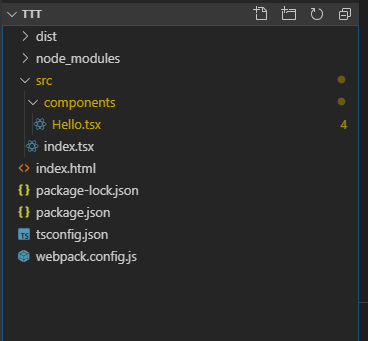:
,
npm init –y
npm install --save-dev webpack webpack-cli
npm install --save react react-dom
npm install --save-dev @types/react @types/react-dom
npm install --save-dev typescript ts-loader source-map-loadertsconfig.json { "compilerOptions": { "outDir": "./dist/", "sourceMap": true, "noImplicitAny": true, "module": "commonjs", "target": "es6", "jsx": "react", "experimentalDecorators": true, "emitDecoratorMetadata": true } }
- src\components\Hello.tsx
- src\index.tsx
- index.html
- src\assets\global.scss
src\components\
Hello.tsx import * as React from "react"; export class Hello extends React.Component { render() { return ( <h1> Hello from TypeScript and React! </h1> ); } }
src\
index.tsx import * as React from "react"; import * as ReactDOM from "react-dom"; import { Hello } from "./components/Hello"; ReactDOM.render( <Hello />, document.getElementById("example") );
index.html <!DOCTYPE html> <html> <head> <meta charset="UTF-8" /> <title>Hello React!</title> </head> <body> <div id="example"></div> <script src="./node_modules/react/umd/react.development.js"></script> <script src="./node_modules/react-dom/umd/react-dom.development.js"></script> <script src="./dist/main.js"></script> </body> </html> src\assets\global.scss .row { display: inline; }
webpack-dev-server
npm install --save-dev webpack-dev-server
npm install --save-dev awesome-typescript-loader
npm install --save-dev html-webpack-plugin
webpack.config.js const path = require('path'); const HtmlWebpackPlugin = require('html-webpack-plugin'); module.exports = { entry: './src/index.tsx', resolve: { extensions: ['.ts', '.tsx', '.js'] }, output: { path: path.join(__dirname, '/dist'), filename: 'bundle.min.js' }, module: { rules: [ { test: /\.tsx?$/, loader: 'awesome-typescript-loader' }, { test: /\.(scss|css)?$/, use: [ { loader: 'style-loader' }, { loader: 'css-loader', options: { importLoaders: 1, }, }, { loader: 'sass-loader', options: { sourceMap: true } }, ], }, ] }, plugins: [ new HtmlWebpackPlugin({ template: './index.html' }) ] }
, mobx React.
"mobx": "4", "mobx-react": "^6.1.1",
C IE10 mobx, 4 , package.json.
"style-loader": "^0.23.1", "css-loader": "^3.1.0", "node-sass": "^4.12.0", "sass-loader": "^7.1.0"
npm install, .
npm install @quantumart/mobx-form-validation-kit package.json
package.json { "name": "ttt", "version": "1.0.0", "description": "", "main": "index.js", "scripts": { "start": "webpack-dev-server --mode development --open", "test": "echo \"Error: no test specified\" && exit 1" }, "keywords": [], "author": "", "license": "MIT", "devDependencies": { "@types/react": "^16.9.5", "@types/react-dom": "^16.9.1", "awesome-typescript-loader": "^5.2.1", "html-webpack-plugin": "^3.2.0", "source-map-loader": "^0.2.4", "ts-loader": "^6.2.0", "typescript": "^3.6.3", "webpack": "^4.41.0", "webpack-cli": "^3.3.9" }, "dependencies": { "@quantumart/mobx-form-validation-kit": "^1.0.8", "mobx": "4", "mobx-react": "^6.1.1", "react": "^16.10.2", "react-dom": "^16.10.2", "webpack-dev-server": "^3.8.2", "style-loader": "^0.23.1", "css-loader": "^3.1.0", "node-sass": "^4.12.0", "sass-loader": "^7.1.0" } }
npm run startHello from TypeScript and React!